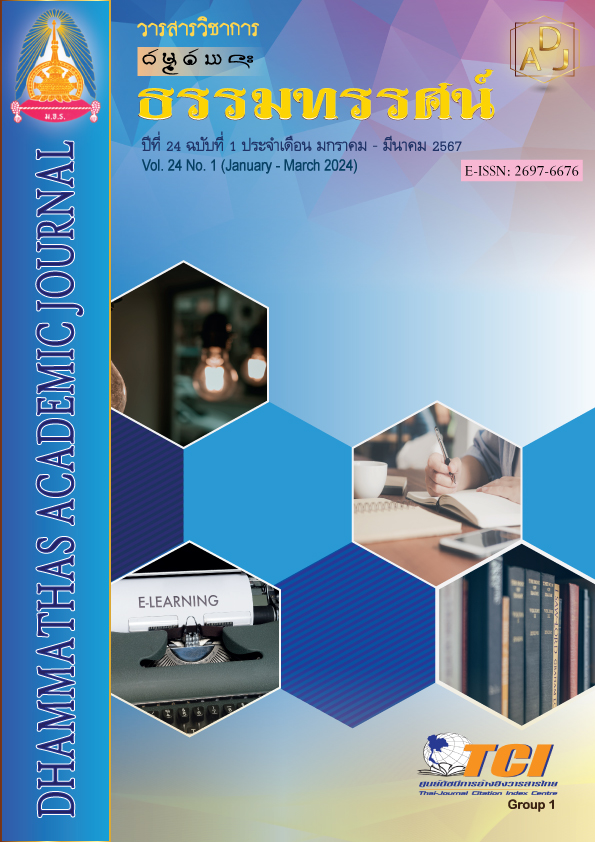Chi Valley Civilization: History Culture and Wisdom in Khon Kean Province
Main Article Content
Abstract
The objectives of this research are; 1) to study the history, culture, and civilization of the Chi River in Khon Kaen province. 2) to study wisdom in the Isaan community and the sources of Chi River Basin civilization in Khon Kaen province. 3) to study the ways for maintaining and inheriting the Chi River civilization. in Khon Kaen province. This is qualitative research. The research tools used were in-depth interviews. Key informants included 7 academicians, 7 local philosophers, and 7 representatives from the government and private sector. Data were analyzed using descriptive methods.
The results showed that:
1. History, culture and civilization of the Chi River in Khon Kaen province. It was found that the history of Khon Kaen city had been started by Thao Phan as the founder, he gathered about 350 persons to set up houses at the edge of Kaen Nakhon lake on the 15th date of the waxing moon of the 4th lunar month in 1789. According to the Provincial Cultural Office of Khon Kaen province, they are as follows: 1) Red Cross Fair, Silk Festival and Xiao Fair 2) Songkran Festival and Khao Neaw Road. According to the Khon Kaen civilization discovered, they were as follows: 1) Prehistoric civilization 2) Historical civilization 3) Dvaradi civilization 4) Lopburi civilization 5) Lan Chang civilization.
2. Wisdom in the Isaan community and the Chi River civilization in Khon Kaen province, it was found that Isaan wisdoms are as follows: 1) Medical wisdom, 2) Wisdom on Food and nutrition, 3) Basketry wisdom, 4) Wisdom on Performing arts, 5) Wisdom on language and literature, 6) Weaving wisdom. The source of civilization in Khon Kaen Province, there is Savathi sub-district civilization.
3. Ways of maintaining and inheriting the source of Chi River civilization in Khon Kaen province were lessons learned from the Savathi sub-district civilization. There are 6 approaches: 1) Creating a museum of local wisdom, 2) Creating the creative art, 3) Creating the creative tourist attractions, 4) Creating the enterprises of community wisdom, 5) creating a network of wisdom and culture, 6) Using wisdom, culture and traditions to develop communities.
Article Details

This work is licensed under a Creative Commons Attribution-NonCommercial-NoDerivatives 4.0 International License.
เพื่อให้เป็นไปตามกฎหมายลิขสิทธิ์ ผู้นิพนธ์ทุกท่านต้องลงลายมือชื่อในแบบฟอร์มใบมอบลิขสิทธิ์บทความ ให้แก่วารสารฯ พร้อมกับบทความต้นฉบับที่ได้แก้ไขครั้งสุดท้าย นอกจากนี้ ผู้นิพนธ์ทุกท่านต้องยืนยันว่าบทความ ต้นฉบับที่ส่งมาตีพิมพ์นั้น ได้ส่งมาตีพิมพ์เฉพาะในวารสาร วิชาการธรรม ทรรศน์ เพียงแห่งเดียวเท่านั้น หากมีการใช้ ภาพหรือตารางของผู้นิพนธ์อื่นที่ปรากฏในสิ่งตีพิมพ์อื่นมาแล้ว ผู้นิพนธ์ต้องขออนุญาตเจ้าของลิขสิทธิ์ก่อน พร้อมทั้ง แสดงหนังสือที่ได้รับการยินยอมต่อบรรณาธิการ ก่อนที่บทความจะได้รับการตีพิมพ์References
จารุวรรณ ธรรมวัตร. (2543). ภูมิปัญญาอีสาน. มหาสารคาม: โครงการตำราคณะมนุษยศาสตร์และสังคมศาสตร์ มหาวิทยาลัยมหาสารคาม.
ชมพูนุท นาคีรักษ์. (2542). มนุษย์กับอารยธรรม. กรุงเทพฯ: ภาควิชาประวัติศาสตร์ คณะสังคมศาสตร์ มหาวิทยาลัยศรีนครินทรวิโรฒ.
ณัฐธยาน์ ตั้งถาวรสกุล. (2558). แนวทางการพัฒนาแหล่งเรียนรู้ทางวัฒนธรรมเพื่อส่งเสริมการเรียนรู้นาฏศิลป์ไทย: กรณีศึกษาศูนย์ศิลปะการแสดง สถาบันคึกฤทธิ์. (วิทยานิพนธ์ศึกษาศาสตรมหาบัณฑิต). กรุงเทพฯ: มหาวิทยาลัยศิลปากร.
ประยงค์ สุวรรณบุบผา. (2537). สังคมปรัชญา แนวคิดตะวันออก-ตะวันตก. กรุงเทพฯ: โอเดียนสโตร์.
พระครูกัลยาณสิทธิวัฒน์ และคณะ. (2548). การมีส่วนร่วมของพระสงฆ์ในการอนุรักษ์วัฒนธรรมท้องถิ่น. (รายงานการวิจัย). พระนครศรีอยุธยา: สถาบันวิจัยพุทธศาสตร์ มหาวิทยาลัยมหาจุฬาลงกรณราชวิทยาลัย.
พระครูวัชรสุวรรณาทร (ลูกชุบ เกตุเขียว) และคณะ. (2562). ผลิตภัณฑ์ท้องถิ่น: คุณค่าอัตลักษณ์และการสร้างมูลค่าเพิ่มด้วยวัฒนธรรมชุมชน. (รายงานการวิจัย). พระนครศรีอยุธยา: สถาบันวิจัยพุทธศาสตร์ มหาวิทยาลัยมหาจุฬาลงกรณราชวิทยาลัย.
สนธยา พลศรี. (2547). ทฤษฎีและหลักการพัฒนาชุมชน. (พิมพ์ครั้งที่ 5). กรุงเทพฯ: โอเดียนสโตร์.

